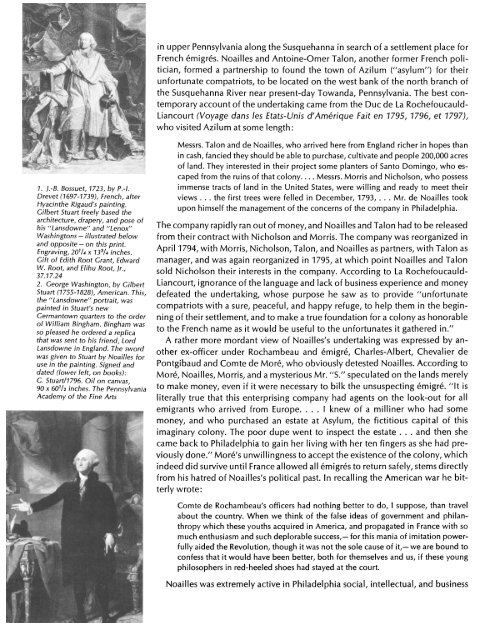The Metropolitan Museum of Art Bulletin, v. 29, no. 7 (March, 1971)
The Metropolitan Museum of Art Bulletin, v. 29, no. 7 (March, 1971)
The Metropolitan Museum of Art Bulletin, v. 29, no. 7 (March, 1971)
Create successful ePaper yourself
Turn your PDF publications into a flip-book with our unique Google optimized e-Paper software.
in upper Pennsylvania along the Susquehanna in search <strong>of</strong> a settlement place for<br />
French emigres. Noailles and Antoine-Omer Talon, a<strong>no</strong>ther former French politician,<br />
formed a partnership to found the town <strong>of</strong> Azilum ("asylum") for their<br />
unfortunate compatriots, to be located on the west bank <strong>of</strong> the <strong>no</strong>rth branch <strong>of</strong><br />
the Susquehanna River near present-day Towanda, Pennsylvania. <strong>The</strong> best contemporary<br />
account <strong>of</strong> the undertaking came from the Duc de La Rochefoucauld-<br />
Liancourt (Voyage dans les Etats-Unis d'Amerique Fait en 1795, 1796, et 1797),<br />
who visited Azilum at some length:<br />
1. J.-B. Bossuet, 1723, by P.-l.<br />
Drevet (1697-1739), French, after<br />
Hyacinthe Rigaud's painting.<br />
Gilbert Stuart freely based the<br />
architecture, drapery, and pose <strong>of</strong><br />
his "Lansdowne" and "Le<strong>no</strong>x"<br />
Washingtons - illustrated below<br />
and opposite - on this print.<br />
Engraving, 207/4 x 133/4 inches.<br />
Gift <strong>of</strong> Edith Root Grant, Edward<br />
W. Root, and Elihu Root, Jr.,<br />
37.17.24<br />
2. George Washington, by Gilbert<br />
Stuart (1755-1828), American. This,<br />
the "Lansdowne" portrait, was<br />
painted in Stuart's new<br />
Germantown quarters to the order<br />
<strong>of</strong> William Bingham. Bingham was<br />
so pleased he ordered a replica<br />
that was sent to his friend, Lord<br />
Lansdowne in England. <strong>The</strong> sword<br />
was given to Stuart by Noailles for<br />
use in the painting. Signed and<br />
dated (lower left, on books):<br />
G. Stuart/1796. Oil on canvas,<br />
90 x 607/2 inches. <strong>The</strong> Pennsylvania<br />
Academy <strong>of</strong> the Fine <strong>Art</strong>s<br />
Messrs. Talon and de Noailles, who arrived here from England richer in hopes than<br />
in cash, fancied they should be able to purchase, cultivate and people 200,000 acres<br />
<strong>of</strong> land. <strong>The</strong>y interested in their project some planters <strong>of</strong> Santo Domingo, who escaped<br />
from the ruins <strong>of</strong> that colony.... Messrs. Morris and Nicholson, who possess<br />
immense tracts <strong>of</strong> land in the United States, were willing and ready to meet their<br />
views . . . the first trees were felled in December, 1793, . . . Mr. de Noailles took<br />
upon himself the management <strong>of</strong> the concerns <strong>of</strong> the company in Philadelphia.<br />
<strong>The</strong> company rapidly ran out <strong>of</strong> money, and Noailles and Talon had to be released<br />
from their contract with Nicholson and Morris. <strong>The</strong> company was reorganized in<br />
April 1794, with Morris, Nicholson, Talon, and Noailles as partners, with Talon as<br />
manager, and was again reorganized in 1795, at which point Noailles and Talon<br />
sold Nicholson their interests in the company. According to La Rochefoucauld-<br />
Liancourt, ig<strong>no</strong>rance <strong>of</strong> the language and lack <strong>of</strong> business experience and money<br />
defeated the undertaking, whose purpose he saw as to provide "unfortunate<br />
compatriots with a sure, peaceful, and happy refuge, to help them in the beginning<br />
<strong>of</strong> their settlement, and to make a true foundation for a colony as ho<strong>no</strong>rable<br />
to the French name as it would be useful to the unfortunates it gathered in."<br />
A rather more mordant view <strong>of</strong> Noailles's undertaking was expressed by a<strong>no</strong>ther<br />
ex-<strong>of</strong>ficer under Rochambeau and emigre, Charles-Albert, Chevalier de<br />
Pontgibaud and Comte de More, who obviously detested Noailles. According to<br />
More, Noailles, Morris, and a mysterious Mr. "S." speculated on the lands merely<br />
to make money, even if it were necessary to bilk the unsuspecting emigre. "It is<br />
literally true that this enterprising company had agents on the look-out for all<br />
emigrants who arrived from Europe. ... I knew <strong>of</strong> a milliner who had some<br />
money, and who purchased an estate at Asylum, the fictitious capital <strong>of</strong> this<br />
imaginary colony. <strong>The</strong> poor dupe went to inspect the estate . . . and then she<br />
came back to Philadelphia to gain her living with her ten fingers as she had previously<br />
done." More's unwillingness to accept the existence <strong>of</strong> the colony, which<br />
indeed did survive until France allowed all emigres to return safely, stems directly<br />
from his hatred <strong>of</strong> Noailles's political past. In recalling the American war he bitterly<br />
wrote:<br />
Comte de Rochambeau's <strong>of</strong>ficers had <strong>no</strong>thing better to do, I suppose, than travel<br />
about the country. When we think <strong>of</strong> the false ideas <strong>of</strong> government and philanthropy<br />
which these youths acquired in America, and propagated in France with so<br />
much enthusiasm and such deplorable success,- for this mania <strong>of</strong> imitation powerfully<br />
aided the Revolution, though it was <strong>no</strong>t the sole cause <strong>of</strong> it,- we are bound to<br />
confess that it would have been better, both for themselves and us, if these young<br />
philosophers in red-heeled shoes had stayed at the court.<br />
Noailles was extremely active in Philadelphia social, intellectual, and business

















